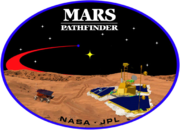 | |
| Mission type | Lander · Rover |
|---|---|
| Operator | NASA · Jet Propulsion Laboratory |
| COSPAR ID | 1996-068A |
| SATCAT no. | 24667 |
| Website | mars |
| Mission duration | 85 days Launch to last contact: 9 months, 23 days |
| Spacecraft properties | |
| Launch mass | 890 kg (includes propellant)[2] |
| Power | Pathfinder: 35 W Sojourner: 13 W |
| Start of mission | |
| Launch date | December 4, 1996 06:58:07 UTC |
| Rocket | Delta II 7925 (#D240) |
| Launch site | Cape Canaveral SLC-17 |
| Contractor | None[3] |
| End of mission | |
| Last contact | September 27, 1997 10:23 UTC |
| Mars lander | |
| Landing date | July 4, 1997 16:56:55 UTC MSD 43905 04:41 AMT |
| Landing site | Ares Vallis, Chryse Planitia, Mars 19°7′48″N 33°13′12″W / 19.13000°N 33.22000°W |
| Transponders | |
| Band | X-Band with high-gain antenna |
| Bandwidth | 6 kb/s to 70 m Deep Space Network, 250 b/s to surface command[2] |
 Official insignia of the Mars Pathfinder mission. | |
Mars Pathfinder[1] was an American robotic spacecraft that landed a base station with a roving probe on Mars in 1997. It consisted of a lander, renamed the Carl Sagan Memorial Station, and a lightweight, 10.6 kg (23 lb) wheeled robotic Mars rover named Sojourner,[4] the first rover to operate outside the Earth–Moon system.
Launched on December 4, 1996, by NASA aboard a Delta II booster a month after the Mars Global Surveyor, it landed on July 4, 1997, on Mars's Ares Vallis, in a region called Chryse Planitia in the Oxia Palus quadrangle. The lander then opened, exposing the rover which conducted many experiments on the Martian surface. The mission carried a series of scientific instruments to analyze the Martian atmosphere, climate, and geology and the composition of its rocks and soil. It was the second project from NASA's Discovery Program, which promotes the use of low-cost spacecraft and frequent launches under the motto "cheaper, faster and better" promoted by then-administrator Daniel Goldin. The mission was directed by the Jet Propulsion Laboratory (JPL), a division of the California Institute of Technology, responsible for NASA's Mars Exploration Program. The project manager was JPL's Tony Spear.
This mission was the first of a series of missions to Mars that included rovers, and was the first successful lander since the two Vikings landed on Mars in 1976. Although the Soviet Union successfully sent rovers to the Moon as part of the Lunokhod program in the 1970s, its attempts to use rovers in its Mars program failed.
In addition to scientific objectives, the Mars Pathfinder mission was also a "proof-of-concept" for various technologies, such as airbag-mediated touchdown and automated obstacle avoidance, both later exploited by the Mars Exploration Rover mission. The Mars Pathfinder was also remarkable for its extremely low cost relative to other robotic space missions to Mars. Originally, the mission was conceived as the first of the Mars Environmental Survey (MESUR) program.[5]
- ^ a b Nelson, Jon. "Mars Pathfinder / Sojourner Rover". NASA. Archived from the original on February 19, 2014. Retrieved February 2, 2014.
- ^ a b "Mars Pathfinder Fact Sheet". NASA/JPL. March 19, 2005. Archived from the original on September 19, 2014. Retrieved February 21, 2014.
- ^ Conway, Erik (2015). "The Discovery Program: Mars Pathfinder". Jet Propulsion Laboratory. Archived from the original on January 17, 2015. Retrieved June 10, 2015.
- ^ "Mars Pathfinder". NASA. Archived from the original on November 12, 2011. Retrieved June 10, 2015.
- ^ Sawyer, Kathy (November 13, 1993). "One Way or Another, Space Agency Will Hitch a Ride to Mars". Washington Post. Retrieved March 6, 2023.